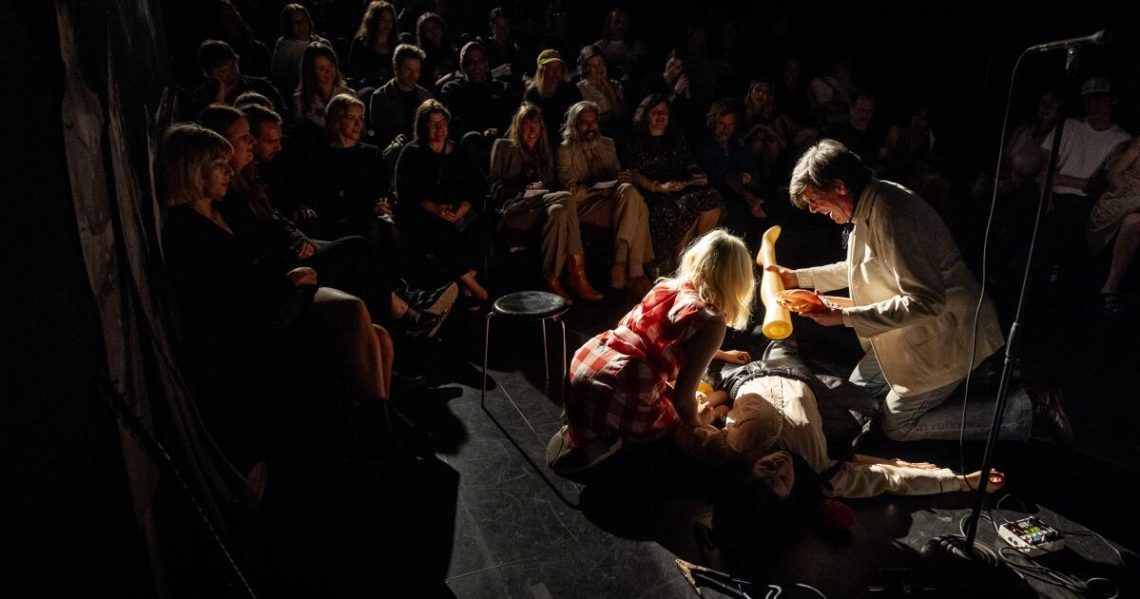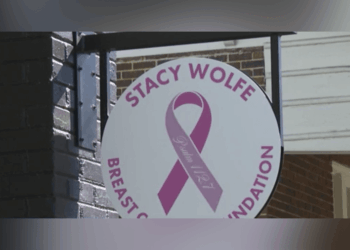Five minutes before showtime, the lead actor of “The Story of Johnny Lightning” — billed as a fusion of stage play, musical and rock documentary — was standing in quiet panic at the end of a long line. The problem wasn’t nerves; it was the bathroom.
New Theater Hollywood, a 49-seat black box on a corner of Santa Monica Boulevard, has just one, tucked behind the stage curtain. To reach it, audience members must cross the stage itself, brushing past the set before the play begins. “I highly recommend not going to the bathroom during the performance,” co-founder Calla Henkel warned the crowd, half in jest. But when the line grew long, the performers peeked out in horror, and the audience kindly let them cut to the front. It was, in miniature, the theater’s whole ethos: a porous boundary between art and life.
In a city where the so-called Theater Row has more “For Lease” signs than marquees, New Theater Hollywood feels improbable. Yet since opening in early 2024, it has already become something of a small cult phenomenon. Co-founded by artists Henkel and Max Pitegoff, the theater hosts an ever-mutable lineup of plays — with titles like “The Mommy Leaks the Floor” and “A Hole Is a Hole” — featuring everyone from first-time performers to Kaia Gerber. Every production, which typically ranges between $25 and $35, has sold out. The theater’s merch, screen-printed by hand in the founders’ backyard onto Hollywood Boulevard tourist T-shirts, circulates like insider currency: Addison Rae’s creative team, local stylists and art-scene fixtures have all been photographed in it.
Earlier this fall, the Hammer Museum gave New Theater Hollywood a spot in its Made in L.A. biennial, premiering their episodic film “Theater” — a work that interweaves documentation from real rehearsals with a fictionalization of their lives as theater owners — inside a room evoking the theater’s lobby, with its red carpeting and sparkly tassels. In just over a year, curator Essence Harden said, “they’ve expanded our understanding of how performance and collectivity can coexist.”
When I visit the venue, Henkel and Pitegoff greet me at the door with the warmth of people who’ve made hospitality part of their art. At their feet circles Bertolt, the mutt they rescued from the street and named, with on-the-nose affection, after the German playwright and director Bertolt Brecht. “He’s not allowed at performances,” Henkel says, as Bertolt barks on and on.
Opening post-pandemic, at a time of rising costs, dwindling audiences and little financial aid, New Theater Hollywood feels like an anomaly. It’s an intricate support system for practitioners to hone their craft in a space dedicated to original theatrical work. New Theater Hollywood has no institutional funding, and only recently secured its first small grant. The theater survives on ticket sales and the founders’ patchwork of side projects, including a $30,000 payment from Yves Saint Laurent, which screened their film “Paradise” in a Paris boutique. “The ticket sales have sustained us so far,” Pitegoff says. “We’re trying to support the artists, but it’s hard when we’re all splitting the same small pot.”
Henkel and Pitegoff’s arrival in Hollywood began as something of a joke. During the pandemic, their previous space, TV Bar in Berlin, was shuttered, leaving them suddenly unmoored. They toyed with the idea of making a film about two artists opening a theater in Los Angeles. Driving along Santa Monica Boulevard scouting locations, they spotted an “Available” sign on an old black-box theater. “We both looked at each other and said, what if we just bought it and called it ‘New Theater Hollywood’?” Pitegoff recalls. Pooling all their artist commissions together, within a week, they had. “There was this looming threat that someone would turn it into a hair salon,” he adds. “We thought, absolutely not.”
Daniel Henning, who served as artistic director of the Blank Theater while it occupied the building before closing in 2022, says the venue — originally known as the Second Stage — first opened in 1984. Its inaugural performance was a play based on English punk musician Sid Vicious, starring a then-unknown actor named George Clooney.
Almost every night, Henkel and Pitegoff hear historical stories like these about the theater from a patron who was once part of the Hollywood scene. Another example: Amy and David Sedaris’ “Book of Liz” played here for an entire year in 2005, Henning said.
Today, the red seats, lighting rig and four chandeliers remain from the theater’s former life — features chosen by Henning. He said he had wanted to create a “tiny Broadway” in Hollywood but had not yet worked up the courage to revisit the space. Henkel and Pitegoff’s only additions are a borrowed piano, a red carpet in the lobby and a few glittering tassels by the bar. “In Berlin,” Henkel explains, “theater is the closest art form to the people. If they don’t like the play, they yell at the stage, and everyone argues afterward about what was said.” New Theater Hollywood, she says, is an attempt to marry the rigor and civic engagement of German theater with Hollywood’s feverish pursuit of charisma.
Henkel and Pitegoff’s working relationship began at Cooper Union, a college in New York City, where they studied art and began collaborating on projects that blurred performance, installation and social practice. “We were interested in theater as a way to avoid the screen,” Pitegoff explains. “When everything was going online, we wanted to bring people together in a room.” In the decade that followed, they became known for creating venues as art projects: spaces that hosted performances, conversations and collaborative experiments. Their ethos, inspired by collectives like the Kitchen and Art Club 2000, centers on art as community infrastructure.
That philosophy finds its fullest expression in New Theater Hollywood, a venue that treats the mechanics of theater-making — the sweeping, mopping, restocking of lime LaCroix — as sacred acts. “Theater is maintenance,” Henkel says. “Even mopping the stage is a beautiful act.” Across the street, five former theaters have been gutted. Of the 20 that once dotted the neighborhood, only two remain: New Theater Hollywood and the Hudson, whose artistic director welcomed them by teaching them to use the lighting rig and gifting them their first mop.
New Theater Hollywood is conceptual and faintly chaotic. “I don’t like the term ‘experimental theater’ because I think it’s diminishing,” says Henkel. “We’re about pushing forms and letting forms relax and expand.” Watching “The Story of Johnny Lightning,” a meta-documentary about the messianic complex of rock ’n’ roll, was both camp and grandiose, narrated by a visibly drunk British writer who downed numerous glasses of wine while reading from his script.
“New Theater Hollywood is home to some of the most experimental, free, wild, weird works of live art I’ve seen in L.A. for a while,” says artist and playwright Asher Hartman, who staged a play there this summer. For actors, too, it offers a reprieve. “There’s always one moment in every play,” Pitegoff says, “when someone looks out and says, ‘This should be a movie, right?’”
In Hollywood, tension usually revolves around the elusive “big break” — that fantasy of sudden transformation. New Theater Hollywood, by contrast, is built for the meantime. Actors come to talk about the long, nerve-racking Ubers to auditions, the endless waiting. Here, they get to make something in real time, with agency and immediacy. “Theater is like rehab for actors,” Henkel says. “You can get so big that you have to come back down.”
Gerber, who was last seen on the big screen in “Saturday Night,” performed at New Theater Hollywood in December in Stephanie LaCava’s adaptation of Italian director Pier Paolo Pasolini’s “The Gospel According to St. Matthew.” It ran for one night only. “That really leaned into the lore of ‘you had to be there,’” says Pitegoff. Musician Kim Gordon, once of Sonic Youth, recently came in to record a voice-over for regular New Theater Hollywood collaborator Jasmine Johnston’s film. “It’s all a kind of gasoline,” Henkel says. “They add fuel to the fire of this city’s star power. It’s an energy, a force. It makes people want to show up.”
They’re booked until summer 2026, their inboxes overflowing with scripts and proposals. “We don’t do revenge,” Henkel laughs when asked about their acceptance criteria. “Yeah, and we don’t do irony,” adds Pitegoff. Over the next two years, the theater will produce roughly a dozen projects annually and commission new works by artists Aria Dean and Marie Karlberg, as well as rapper Mykki Blanco.
At every turn, Henkel and Pitegoff are omnipresent — sweeping floors, tending bar, sitting in on rehearsals. They rarely work with finished products; instead, they nurture embryonic ideas. “You’re living inside another person’s megalomania,” Henkel says. “Sometimes we’ll sit in our cars and realize we’ve been speaking in dialogue from someone else’s play.”
In the process, they’ve cultivated not just a venue but a scene — no small feat in Los Angeles. Every night, the crowd gathers: artists, stylists, musicians, first-timers, veterans, all dressed in their own registers of fabulousness. There are usually a few excellent hats. No two haircuts are alike.
In a city overflowing with people who make a living pretending — but rarely in a theater — New Theater Hollywood proposes another kind of stage: new, and somehow still Hollywood.
The post How a tiny L.A. theater became an IYKYK destination appeared first on Los Angeles Times.




